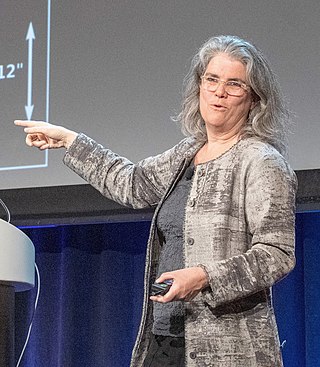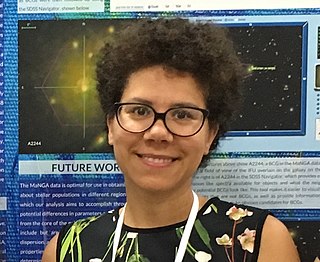
Annie Jump Cannon was an American astronomer whose cataloging work was instrumental in the development of contemporary stellar classification. With Edward C. Pickering, she is credited with the creation of the Harvard Classification Scheme, which was the first serious attempt to organize and classify stars based on their temperatures and spectral types. She was nearly deaf throughout her career after 1893, as a result of scarlet fever. She was a suffragist and a member of the National Women's Party.

Eleanor Margaret Burbidge, FRS (née Peachey; 12 August 1919 – 5 April 2020) was a British-American observational astronomer and astrophysicist. In the 1950s, she was one of the founders of stellar nucleosynthesis and was first author of the influential B2FH paper. During the 1960s and 1970s she worked on galaxy rotation curves and quasars, discovering the most distant astronomical object then known. In the 1980s and 1990s she helped develop and utilise the Faint Object Spectrograph on the Hubble Space Telescope. Burbidge was well known for her work opposing discrimination against women in astronomy.

Andrea Mia Ghez is an American astrophysicist and professor in the Department of Physics and Astronomy and the Lauren B. Leichtman & Arthur E. Levine chair in Astrophysics, at the University of California, Los Angeles. Her research focuses on the center of the Milky Way galaxy.

Antonia Caetana de Paiva Pereira Maury was an American astronomer who was the first to detect and calculate the orbit of a spectroscopic binary. She published an important early catalog of stellar spectra using her own system of stellar classification, which was later adopted by the International Astronomical Union. She also spent many years studying the binary star Beta Lyrae. Maury was part of the Harvard Computers, a group of female astronomers and human computers at the Harvard College Observatory.

Alexei Vladimir "Alex" Filippenko is an American astrophysicist and professor of astronomy at the University of California, Berkeley. Filippenko graduated from Dos Pueblos High School in Goleta, California. He received a Bachelor of Arts in physics from the University of California, Santa Barbara in 1979 and a Ph.D. in astronomy from the California Institute of Technology in 1984, where he was a Hertz Foundation Fellow. He was a postdoctoral Miller Fellow at Berkeley from 1984 to 1986 and was appointed to Berkeley's faculty in 1986. In 1996 and 2005, he a Miller Research Professor, and he is currently a Senior Miller Fellow. His research focuses on supernovae and active galaxies at optical, ultraviolet, and near-infrared wavelengths, as well as on black holes, gamma-ray bursts, and the expansion of the Universe.
Dame Carole Jordan, is a British physicist, astrophysicist, astronomer and academic. Currently, she is Professor Emeritus of Astrophysics at the University of Oxford and Emeritus Fellow at Somerville College, Oxford. From 1994 to 1996, she was President of the Royal Astronomical Society; she was the first woman to hold this appointment. She won the Gold Medal of the Royal Astronomical Society in 2005; she was only the third female recipient following Caroline Herschel in 1828 and Vera Rubin in 1996. She was head of the Rudolf Peierls Centre for Theoretical Physics at the University of Oxford from 2003 to 2004 and 2005 to 2008, and was one of the first female professors in Astronomy in Britain. She was made a Dame Commander of the Order of the British Empire in 2006 for services to physics and astronomy.
Priscilla Fairfield Bok was an American astronomer and the wife of Dutch-born astronomer Bart Bok, Director of Mount Stromlo Observatory in Australia and later of Steward Observatory in Arizona, US. Their harmonious marriage accompanied the four decades of their close scientific collaboration, in which "it is difficult and pointless to separate his achievements from hers". They co-authored a number of academic papers on star clusters, stellar magnitudes, and the structure of the Milky Way galaxy. The Boks displayed great mutual enthusiasm for explaining astronomy to the public: described as "salesmen of the Milky Way" by The Boston Globe, their general interest book The Milky Way went through five editions and was said to be "one of the most successful astronomical texts ever written".
Charles Thomas Bolton was an American-Canadian astronomer who was one of the first in his field to present strong evidence of the existence of a stellar-mass black hole.
The Marc Aaronson Memorial Lectureship, also known as the Aaronson Prize, is an award of the University of Arizona Department of Astronomy and Steward Observatory which promotes and recognizes excellence in astronomical research. It is named after astronomer Marc Aaronson, who died in 1987 in an accident while making astronomical observations. He was 36 years old.
Christopher David Impey is a British astronomer, educator, and author. He has been a faculty member at the University of Arizona since 1986. Impey has done research on observational cosmology, in particular low surface brightness galaxies, the intergalactic medium, and surveys of active galaxies and quasars. As an educator, he has pioneered the use of instructional technology for teaching science to undergraduate non-science majors. He has written many technical articles and a series of popular science books including The Living Cosmos, How It Began, How It Ends: From You to the Universe, Dreams of Other Worlds, and Humble Before the Void. He served as Vice-President of the American Astronomical Society, he is a Fellow of the American Association for the Advancement of Science, and a Howard Hughes Medical Institute Professor. He serves on the Advisory Council of METI.

Claudia Megan Urry is an American astrophysicist, who has served as the President of the American Astronomical Society, as chair of the Department of Physics at Yale University, and as part of the Hubble Space Telescope faculty. She is currently the Israel Munson Professor of Physics and Astronomy at Yale University and Director of the Yale Center for Astronomy and Astrophysics. Urry is notable not only for her contributions to astronomy and astrophysics, including work on black holes and multiwavelength surveys, but also for her work addressing sexism and sex equality in astronomy, science, and academia more generally.

Sidney Carne Wolff is an American astrophysicist, researcher, public educator, and author. She is the first woman in the United States to head a major observatory, and she provided significant contributions to the construction of six telescopes. Wolff served as Director of the Kitt Peak National Observatory (KPNO) and the National Optical Astronomy Observatory (NOAO). She is a member of the International Astronomical Union's Division G: Stars and Stellar Physics.
Nancy Houk is an American astronomer who led the effort to establish a comprehensive database of stellar temperatures and luminosities.

Paul Geoffrey Murdin is a British astronomer. He identified the first clear candidate for a black hole, Cygnus X-1, with his colleague Louise Webster.

Alice Hall Farnsworth was an American astronomer. She was director of John Payson Williston Observatory at Mount Holyoke College from 1936 until her retirement in 1957.

Louise Olivia Violet Edwards is a Canadian astronomer and associate professor of physics at California Polytechnic State University, and is one of the first Black Canadians to receive a PhD in astronomy. In 2002, she was pictured on a Canadian stamp.
Laura Elizabeth Hill Mclaughlin was a computer, instructor and researcher of astronomy. As an astronomer of the Detroit Observatory for the University of Michigan, she conducted research work alongside her husband, fellow Detroit Observatory astronomer Dean B. Mclaughlin.
Kathleen DeGioia Eastwood is an American astronomer known for her research on the formation and evolution of massive stars, and for her work on undergraduate education in astronomy. She is a professor emerita of astronomy and planetary science at Northern Arizona University.
Eileen Dolores Friel is an American astronomer specializing in the metallicity of star clusters. She is a former director of the Maria Mitchell Observatory and Lowell Observatory, and a professor emeritus of astronomy at Indiana University.

Benjamin Franklin Peery, Jr., was an American physicist, astronomer, and longtime professor at Indiana University and Howard University. He was the second African American person to receive a doctorate in astronomy.











